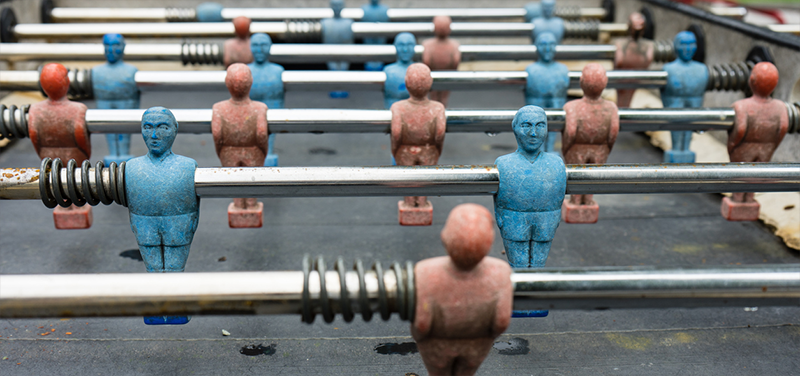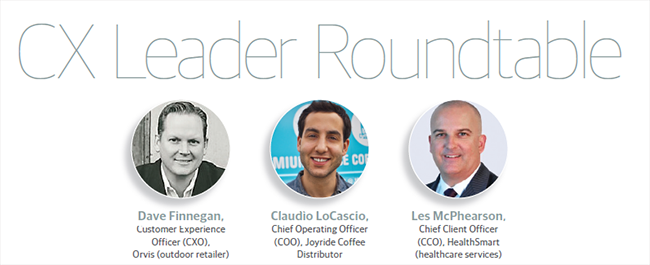CX Is a Team Sport
Responsibility for the customer experience can be found in many places.

The question of who owns the customer experience is not always easy to answer. Traditionally, it’s been thought that the chief marketing officer (CMO) is the obvious leader of the customer experience. In a recent survey by The Economist Intelligence Unit and Marketo, 86 percent of CMOs said they will own their company’s customer experience by 2020.
But as we see old and influential organizations transform and vibrant forward-thinking startups arise, it is evident that traditional ways of thinking are not permanent. As the innate value of customer experience becomes more recognized, experts and C-suite leaders alike see new positions take on the mantle of championing the customer’s journey, and multiple departments are working together to share the responsibility for customer success.
What do the experts say?
Some analysts can be heard chanting that “everybody” should own the customer experience in their organization. Several thought leaders see this as too simple of a plan. Sue Duris, a customer experience specialist, agrees that when everyone owns the customer experience, nobody does. She says a CEO must champion a customer experience-focused culture and position executives such as chief customer officers (CCOs) to lead it.
“As an employee I want to know what the vision is, how I’ll fit in, and how it’s going to enable me to take ownership,” says Duris. She explains that CEOs should nurture a mindset that identifies how every level fits into the spoke of the wheel.
Rather than focusing the customer experience onto one individual, or by oversimplifying it by saying it’s entirely owned by the company, this distribution has a centralized leader that inspires the thought. This allows concepts to cascade down to officers that can manage it in several silos instead of one.
When only one department takes sole ownership, however, the customer experience may get fragmented, Duris says. For example, marketing’s customer-facing focus may miss the potential reach of customer centricity across the organization in all departments. She envisions a Chief CCO-led, cross-functional team as a better alternative to cover the interactions that happen post purchase: retention, loyalty, and advocacy.
Diane Magers, CEO of the Customer Experience Professionals Association (CXPA), imagines the ideal owner to be a C-suite type, like a CCO, who acts as an umbrella over the organization. Someone who is agnostic to business units and works to orchestrate the experience across the brand. This is a move past the traditional surveys to gather information and more toward ownership and accountability of a customer experience movement.
Magers cites Anthem Health as a good example of customer champion organizations. “They know that every experience a customer has can drive how they field their behavior,” she says. “Whether they are going to buy or recommend more, they are very systematic about it, they have done a more holistic approach and it’s a part of their DNA.”
There is no one ideal position who should own the customer experience. Each company structure and operations is unique. As a result, there are a variety of executives who are responsible for their brand’s customer experience.
The marketing POV
Marketing is still the dominant CX ownership discipline. And according to those interviewed in The Economist Intelligence Unit study, marketers have the advantage because they can focus attention on personalization, customer behavior, and the overall customer journey. Here is what some top marketers said in the study:
Jonathan Martin, CMO, Pure Storage:
“Today, the primary task of CMOs is to deeply understand customer buying behavior and intent; deeply understand the context of where someone is in their decision journey; be able to predict what they’re most likely primed to do next, and be ready to influence them at the right moment.”
Kristin Lemkau, CMO, JPMorgan Chase:
“Achieving personalization at scale is the biggest and most important challenge for us to get right. So we have to work hard to create the kind of infrastructure that supports personalized marketing that doesn’t feel like an ad or invasion, but feels like a benefit that’s available at the right point of a purchase cycle to acquire it.”
Keith Weed, CMO, Unilever:
“Brands need to help people simplify life so we all don’t go mad as this world becomes more complex. I believe that people who focus on that will unlock the true power of data.”
While marketing may dominate CX ownership, there are plenty of companies that structure things differently. At online community site Pinterest, the customer experience is overseen by Chief Technical Officer Vanja Josifovski. He told a recent Forrester conference audience that technology is the backbone behind the company’s goal to help users to improve their lives.
“You need different parts of the company acting as a whole” toward the goal, he said. If you want to build a great company, he added, you need to focus on building value to the user by solving their problems and finding a way to make money. It’s not about being everything to everyone. “We try to focus on a few use cases,” he said.
Building on Josifovski’s thoughts, we sat down with three executives in charge of the customer experience who bring a unique sensibility to the position of CX leader.

Customer Strategist: Typically customer experience falls under marketing or service disciplines. Why is it owned by your department? What are the benefits and challenges to having it under your department?
Dave Finnegan, Orvis: My role is a hybrid of a CMO and a CIO. I have found that it takes a great blend of marketing and tech to truly provide amazing experiences to our guests. The benefits of having us work together are very impactful. Our business and strategy conversations have technology at the table from day one. We are all committed to our guests. We discuss opportunities together and how we can work together to make those experiences deliver on our commitment and drive value for our company. We are seeing some great results from our work together.
Claudio LoCascio, Joyride: For most of our customers, the Joyride experience begins with a conversation with someone on our sales team and ends with them enjoying one of our amazing products, so my departments bookend the customer experience. But there are many steps in between, all of which need to be carefully coordinated in order to make sure that we provide the highest possible level of service to our customers. This means careful communication with the fulfillment and equipment service teams, and often fully integrated systems to ensure data integrity. The customer experience is only as strong as the weakest link in that chain.
Les McPhearson, HealthSmart: The customer experience falls under client services because HealthSmart partners with every service that plan sponsors need to reduce healthcare costs and serve members with dignity and respect. As we help employers and their employees with service, support, and intelligence, the customer experience model is enhanced as we partner with marketing and customer service.
CS: Based on your expertise and experience, what do you bring to the role that is unique to create great customer experiences?
LoCascio: Throughout my time at Joyride, I’ve been fortunate to have exposure to almost all aspects of the business, from sales to systems. And even earlier in my career, whether I was building data systems at Bridgewater Associates or launching a sake portfolio at Winebow, I was able to get broad exposure into how different businesses operated. This experience lets me anticipate the impact a change in one part of the business will have on the rest of the company, and ensure that our various initiatives are coordinated to create the holistic, premium customer experience we are striving for.
CS: Can you provide a specific example of a successful customer initiative? How was it influenced by your unique expertise?
McPhearson: Creating an online enrollment system that allowed members to analyze previous year’s claims and pharmacy costs and model future life events (e.g., birth of a child) to optimize their plan selection and costs (both premium and out-of-pocket) helped tens of thousands of members improve their selection and utilization of their benefits.
LoCascio: Joyride strives to provide our customers access to the finest craft beverages available anywhere. Often, this means working with smaller, local producers and doing things like getting coffees roasted to order—decisions that are necessary to achieve the highest quality, but that also add significant logistical complexity. We didn’t want any of that complexity to be passed on to our customers, so we developed a proprietary system that alerts customers about upcoming order deadlines based on a variety of factors, such as location, purchase history, and order frequency. We even go so far as to suggest order quantities.
All of this is in order to allow our customers to get the highest possible quality with the least hassle.
In spearheading this project, I not only had to translate the needs and suggestions of the sales team into logic that our developers could work with, I also had to ensure that the scheduling would integrate seamlessly with all of our operational processes, from production to fulfillment. I wouldn’t have been able to do that without such a broad understanding of the business.
CS: What other departments do you work with on customer experience initiatives? What gaps do they fill?
Finnegan: Every great experience starts with great product. Great product is the number one thing we can do as an organization to deliver on the experience. It’s important to us to deliver great product, but also make sure our guests get what they need when they need it. Because of this, working with our merchants and planners is key. We combine that with working closely with our creative, finance, and retail ops teams to discuss the experience together.
We have two tools that have proven valuable to us. First, we are developing a merchandise and marketing calendar that identifies when we need to have product (and at what inventory level) and is focused on the optimal customer purchase timing. And second, as part of that calendar we have a process we call “Playbacks.”
We choose a time period and we have the marketing, product, and creative teams walk us through the consumer insight, campaigns, and creative for that period, so we can see the key stories and how it feels to our guests. Playbacks help to ensure we are working together, make sure we have the right product and we are delivering the right guest experience.
LoCascio: The operations team is vital to maintaining the integrity of our customer experience. After all, as the ones who deliver our product and service our equipment, they are the ones who have the most face-to-face interaction with our customers out of anyone in the company! This means that not only do we have to ensure that they are just as focused as the rest of us on providing a great customer experience, but we also involve them in all new product and service initiatives. Our customers might not feel as comfortable adding kombucha to their kegerator if the person delivering it has no idea what the product is!
McPhearson: In partnering with our CIO and VP of marketing, we are evolving to help provide a more intimate, individual experience.
CS: Has your role changed or evolved since you began?
LoCascio: Absolutely. A fast-growing company like Joyride is always evolving as we continue to grow and strive to innovate to better serve our customers. When I joined Joyride in 2014, the company was still primarily a distributor of craft coffee beans and hot coffee equipment, and only operated in the metro New York area. Now we are the leading distributor of nonalcoholic kegs in four major markets across the country and generate considerable sales from new categories like cold brew tea, kombucha, and nitro cold brew. But even throughout such a dramatic transformation, we kept a dedication to quality and service as a guiding principle, and thankfully that resonated with the majority of our customers, who stuck with us throughout the company’s development.
CS: How do you see your role and your company’s approach to customer experience evolving?
Finnegan: In some parts of our company we use consumer insight and customer interactions to help shape our products and marketing. In other parts of our organization that is still an opportunity for us. We are all committed to a great customer experience and you will see us continue to take steps that deliver on that commitment by using customer insight and inviting our guests to give us their perspective early on in the process.
I have been in the retail industry for a couple of decades now and what’s interesting is that how we reach and interact with consumers has changed dramatically in that time. But what hasn’t changed is the emotional connections that make us human. I think brands who get this emotional connection with their valued customers and can combine that with great interactions will be best positioned for the future.
LoCascio: My role will no doubt continue to evolve as the company grows in new and unexpected ways. But our mission is to preserve the company culture and values, and continue to provide an unparalleled customer experience, regardless of what products or services we are providing.
McPhearson: Most people don’t think about a great customer experience when they think of their benefits. HealthSmart is going to change that.





